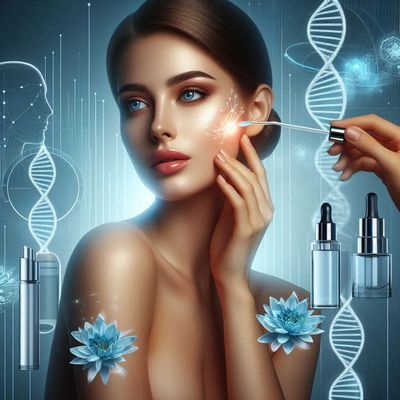Signed in as:
filler@godaddy.com
Signed in as:
filler@godaddy.com

In cosmetic formulation, achieving uniform skin tone and mitigating hyperpigmentation are key challenges. Natural enzymes offer a scientifically validated, biocompatible solution to these concerns.
Tyrosinase is a pivotal enzyme in melanin biosynthesis. By inhibiting tyrosinase activity, melanin production is reduced, leading to more even and luminous skin. Compounds in natural enzymes, such as bromelain and papain, have demonstrated effective tyrosinase inhibition in multiple studies.
BioZymes AgeBoss System promotes apoptosis of hyperactive melanocytes and accelerates cell turnover. This process ensures removal of excess melanin-producing cells, speeding up depigmentation while supporting natural skin renewal cycles.
A key advantage of BioZymes AgeBoss System is its ability to reduce inflammatory mediators in the skin, minimizing irritation and preventing unwanted side effects often associated with chemical depigmenting agents. This ensures a safer, more tolerable formulation for sensitive skin, while maintaining high depigmentation performance.
Enzymes derived from fruits (e.g., pineapple bromelain, papaya papain) not only inhibit melanin production but also provide mild exfoliation. By promoting cell renewal without damaging the skin barrier, they help achieve brighter, more uniform skin tone over time.
Incorporating BioZymes AgeBoss System into cosmetic formulations offers dual benefits: effective depigmentation through tyrosinase inhibition and apoptosis/cell turnover, coupled with anti-inflammatory protection for a gentle application. This combination enables formulators to develop high-performance products that are safe, effective, and well-tolerated by consumers.
The use of natural enzymes, specifically through BioZymes AgeBoss System, represents a scientifically supported strategy for reducing hyperpigmentation, balancing skin tone, and enhancing overall skin health. Its unique combination of efficacy without irritation and inflammatory compound reduction makes it a superior choice for advanced cosmetic formulations targeting skin depigmentation.
Hydrolysates generated with enzymes including papain showed potent tyrosinase inhibition. The fraction of peptides (1-3 kDa) had highest inhibitory activity.
Optimized papain hydrolysis conditions for marine organism; hydrolysates achieved measurable tyrosinase inhibition (e.g. ~31.5% and ~25.4%) depending on substrate. Shows papain’s capability in generating antityrosinase peptides.
Papain hydrolyzed rice bran albumin yielded peptides with strong mushroom tyrosinase inhibitory effect, even better than some standards. Shows papain’s effectiveness in producing bioactives that block tyrosinase.
Hydrolysis with papain & bromelain increased tyrosinase inhibitory activity significantly relative to non-hydrolyzed controls. Demonstrates how these enzymes boost performance in natural extracts.
Shows that papain-digested products had very high tyrosinase inhibition (≈81%) compared to other proteases. Valuable for supporting potency of papain-derived actives.
Shows that nitric oxide (NO) can trigger apoptosis in normal human epidermal melanocytes via the intrinsic (mitochondrial) pathway. This supports that melanocytes can be induced to die (apoptosis) under certain stimuli.
Reviews evidence that apoptosis (rather than necrosis) plays a role in melanocyte loss in vitiligo—i.e. apoptotic pathways are relevant for depigmentation by cell removal.
Although this focuses more on autophagy, it also addresses cell renewal, turnover, and how pigment cells are degraded or maintained. Helps show related mechanisms of pigment removal and regulation.
Damage-homeostasis balance in melanocytes involves both autophagy and turnover of melanosomes; while not exactly “apoptosis + cell proliferation,” it supports that modulation of cellular processes can lead to pigment reduction.
Discusses how deficient adhesion leads to melanocyte detachment and apoptosis—one pathway by which melanocyte numbers reduce, contributing to depigmentation. Relevant to the idea of removing melanocytes via controlled apoptosis.

Shows that papain reduced inflammatory cytokines, reduced TEWL (transepidermal water loss), reduced epidermal thickness and mast cell infiltration in a mouse model of atopic dermatitis; inhibited MAPKs and STAT pathways. Suggests anti-inflammatory effects and gentleness in damaged/inflamed skin.
Demonstrates that bromelain lowers interleukin-1β, IL-6, IL-8, ICAM-1, VCAM-1 in LPS-stimulated human cells; shows reduced activation of NF-κB and MAPK pathways; also reports no major cytotoxicity in tested concentrations. Supports safety/gentleness.
In multiple human trials, supplementation with bromelain was associated with reductions in inflammatory markers (IL-6, IL-8, TNF-α, etc.), showing systemic anti-inflammatory signaling; suggests tolerability in humans.
A randomized double-blind controlled skin study (40 participants, 12 weeks) showing that topical bromelain decreased redness/inflammation, improved texture, with mild irritation in a minority — supports effectiveness with low side effects.
Demonstrates that bromelain and papain from fruit by-products are highly effective exfoliants, break down keratin proteins to gently remove dead skin cells, improve texture, dullness and hyperpigmentation. Compares their exfoliation efficacy and notes minimal irritation possible with proper formulation.
Reviews studies up to 2021 where enzymes (including papain, bromelain, keratinases) were used as exfoliants. Finds that enzymes can improve skin surface appearance, smoothness, brightness while being gentler than many chemical exfoliants.
Details how bromelain, as a proteolytic enzyme, hydrolyzes dead skin cells on the skin surface, removes proteins from the stratum corneum, and affects pathways like MITF to reduce melanin synthesis. Supports the idea of both exfoliation and pigment reduction.
This website uses cookies. By continuing to use this site, you accept our use of cookies.